Honda Pilot: Navigation System Description - Overview
Basic Configuration
The navigation system is a highly-sophisticated hybrid locating system that uses satellites and a map database to show you where you are and get you to a destination.
The navigation system receives signals from the GPS (global positioning system) and a network of 24 or more satellites in orbit around the earth. By receiving signals from several of these satellites, the navigation system can determine the latitude, longitude, and elevation of the vehicle. In addition, the signals from the system's yaw rate sensor and the PCM (vehicle speed pulse) enable the system to track the vehicle direction and speed.
This hybrid system has advantages over some dependent systems such as the self-contained type and the GPS-dependent type. For example, the system can track the vehicle position even when satellite signals cannot be received like the self-contained type. In addition, the system also can track the vehicle position even when the vehicle is transported by a ferry like the GPS-dependent type.
The navigation system applies all location, direction, and speed information to the maps and calculates a route to the chosen destination. When you are driving, the system provides both the visual and the audio guidance.
SD Card
The audio-navigation unit uses a SD card as a storage media that saves the map data, dictionary of voice recognition, system data, backup data, and applications. The audio-navigation unit and the SD card cannot be replaced separately.
Audio-Navigation Unit
Refer to the Audio System Overview for the audio-navigation unit and the audio functions.
Navigation Function
The basic navigation system is composed of the audio-navigation unit, vehicle signal (vehicle speed pulse, reverse signal), and GPS antenna.
The audio-navigation unit calculates the vehicle position and guides you to the destination. The unit performs the map matching correction, GPS correction, and distance tuning. It also controls the menu functions and interprets the voice commands. With the controls of all these items, the audio-navigation unit produces the navigation picture signal and sends the signal to the display.
Function Diagram
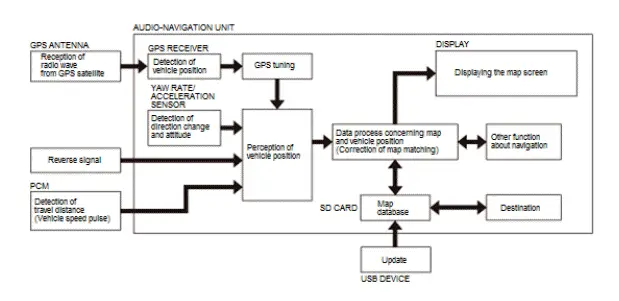
Calculation of Vehicle Position
The audio-navigation unit calculates the vehicle position (the driving direction and the current position) by receiving the directional change signals from the yaw rate sensor and the acceleration sensor, the travel distance signals from the vehicle speed pulse (VSP) of the PCM and the BACK-LT (reverse) signal.
Map Matching Tuning
The map matching tuning indicates the vehicle position properly on the map. The map data transmitted from the SD card is compared to the current vehicle position data and indicates its approximate position on the map. The map matching tuning does not work when the vehicle is on an unmapped road or far away from a mapped road.
GPS Tuning
GPS tuning improves the accuracy of the actual vehicle position using the GPS. The audio-navigation unit compares its calculated vehicle position with the GPS position. If there is a large difference between the two positions, the GPS tuning adjusts the calculated vehicle position to the GPS position.
Distance TuningThe audio-navigation unit compares the value based on the VSP with the GPS data and calculates the distance between them.
Because the value based on VSP is located on ahead or behind the GPS position, the audio-navigation unit decreases or increases the value and compensates the distance.
Vehicle Speed Pulse
The vehicle speed pulse is sent by the PCM. The PCM receives signals from the output shaft speed sensor. Then, the PCM processes and transmits them to the speedometer and other systems.

Yaw Rate/Acceleration Sensor
The yaw rate sensor and the acceleration sensor (located in the audio-navigation unit) detects the direction change (angular speed) and the attitude of the vehicle.
Oscillation Gyro Principles
The yaw rate sensor is an oscillation gyro built into the audio-navigation unit. The piezoelectric parts have electric/mechanical transfer characteristics. They bend vertically when a voltage is applied to both sides of the parts and generate a voltage between both sides of the piezoelectric parts when they are bent by an external force. The oscillation gyro functions by utilizing this characteristic of the piezoelectric parts and the Coriolis force. (The Coriolis force deflects moving objects as a result of the earth's rotation.) In the oscillation gyro, this force moves the sensor element when a angular velocity is applied.
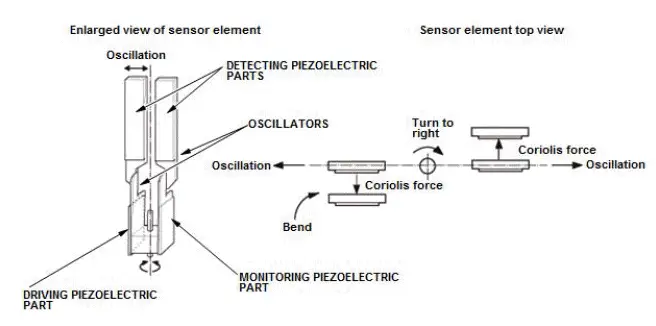
Yaw Rate Sensor
When the vehicle turns left or right, the yaw rate sensor outputs a voltage. However, the sensor outputs an offset voltage when the vehicle is stopped. The audio-navigation unit calculates the relative bearing of the vehicle from the offset voltage. Since the vehicle may generate the yaw rate even when it is stopped (when the vehicle is spun on a turn table), the audio-navigation unit inhibits the incorrect calculation using the yaw rate sensor temperature information.
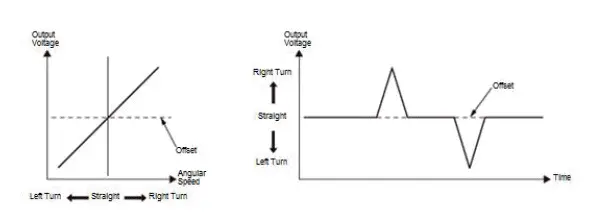
Auto Tuning
The sensitivity behavior of the yaw rate sensor has an individual specificity and it is necessary to calculate a sensitivity correction coefficient for every unit. A sensitivity correction coefficient is automatically learned when the vehicle is moving.
Acceleration Sensor
When the vehicle accelerates and slows down, the acceleration sensor outputs a voltage. Since the sensor is affected when the vehicle is slanted (such as driving or stopped on a hill), the audio-navigation unit calculates the slant angle of the vehicle based on the offset voltage.
Because of calculating the slanting of vehicle correctly, the audio-navigation unit sets up the offset in these cases:
- The GPS altitude is constant.
- The vehicle speed is constant.
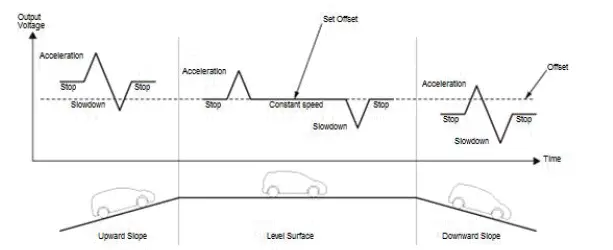
Global Positioning System (GPS)
The global positioning system (GPS) enables the navigation system to determine the current position of the vehicle by using the signals transmitted from the satellites in orbit around the earth. The satellites transmit the satellite identification signal, orbit information, transmission time signal, and other information. When the GPS receiver receives the signals from four or more satellites simultaneously, it calculates the current position of the vehicle based on the distance to each satellite and the satellite's position in its respective orbit.
Position Detection Image with GPS Satellite
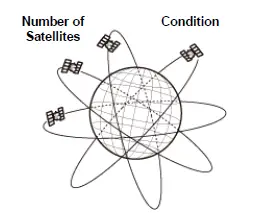
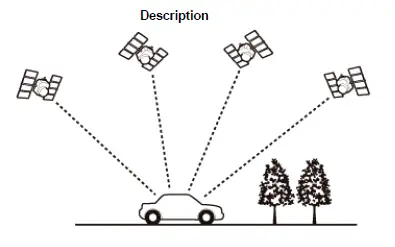
Precision of GPS
The precision of the GPS varies according to the number of satellites from which signals are received and the conditions of the sky.
| Number of Satellites | Condition | Description |
| None | Faulty reception | The GPS cannot be utilized due to a faulty GPS receiver or antenna, or other fault or interference. |
| 2 or less | Impossible to detect vehicle position | The GPS function is normal. The satellite signals received by the GPS are too few to detect the vehicle position. |
| 3 | Vehicle position detectable in 2 dimensions | The longitude and latitude of the vehicle position can be detected (less precise than detection in three dimensions). |
| 4 or more | Vehicle position detectable in 3 dimensions (elevation displayed) | The longitude, latitude and altitude of the vehicle position can be detected (more precise than the detection in two dimensions). |
GPS Antenna
The GPS antenna amplifies the signals received from the satellites and transmits them to the GPS receiver.
GPS Receiver and Clock
The GPS receiver is built into the audio-navigation unit. It calculates the vehicle position by receiving the signals from the GPS antenna. The current time, vehicle position and signal reception condition are transmitted from the GPS receiver to the audio- navigation unit to adjust the vehicle position and the clock in the display and in the gauge control module.
Audio Guidance
The audio-navigation unit outputs navigation voice guidance before entering an intersection or passing a junction.
With stereo amplifier: The voice guidance is sent to the stereo amplifier via the AUX NAVI line, and then outputs them to the front center speaker.
Turn by Turn Directions
The audio-navigation unit outputs the route guidance (direction) information to the multi-information display in the gauge control module via the B-CAN. In the case of the route guidance mode, the multi-information display shows the simple routing guidance using arrows. In the case of other than the route guidance mode, the multi-information display shows the azimuth (direction) information in 16-directions.
Voice Control Function
This navigation system also has the voice recognition that allows the voice control of most of the navigation functions. The voice control is activated by the TALK button on the steering wheel. The voice control also allows the control of the audio and climate functions.
If a vehicle is equipped with the climate control and the driver is using the voice recognition, the audio-navigation unit sends the fan mute signal to the climate control unit via the B-CAN bus. The blower fan operating voltage may be reduced depending on the current fan speed.
HD Traffic
The HD Traffic is a broadcast for delivering traffic information to the driver. The HD Traffic data is supplied by the FM broadcast.
The HD Traffic uses a decoder in the audio-navigation unit to decode the traffic information data. It is integrated directly into a navigation system. The traffic information is displayed with the navigation route guidance. It is used to avoid traffic jams and accidents (see the Navigation System Manual for more information).
Multi-View Rear Camera System
The multi-view rear camera system allows the driver to see what is behind the vehicle by displaying the image on the audio-navigation unit. There are three different selectable views. Refer to the Audio System Overview.
HondaLink911
The HondaLink delivers remote services to the vehicle using a cell phone compatible with Bluetooth. Refer to the Audio System Overview.
Navigation Voice Control Switch
- TALK Button: Activates the voice control system in the audio-navigation unit to accept voice commands.
- HANG-UP/BACK Button: Returns the display to the previous screen (similar function as the CANCEL button), or is used to end a call.
- PICK-UP Button: This button is used to answer incoming calls or to make outgoing calls. You can also go directly to the Phone screen by pressing this button.
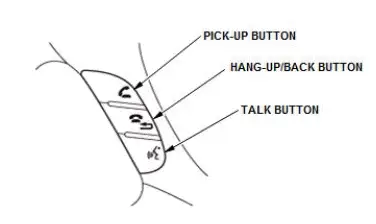
Navigation Microphone
For the contents of the navigation microphone, refer to the Front Microphone in Audio System Overview.
Navigation System Description - System Diagram
With Stereo Amplifier
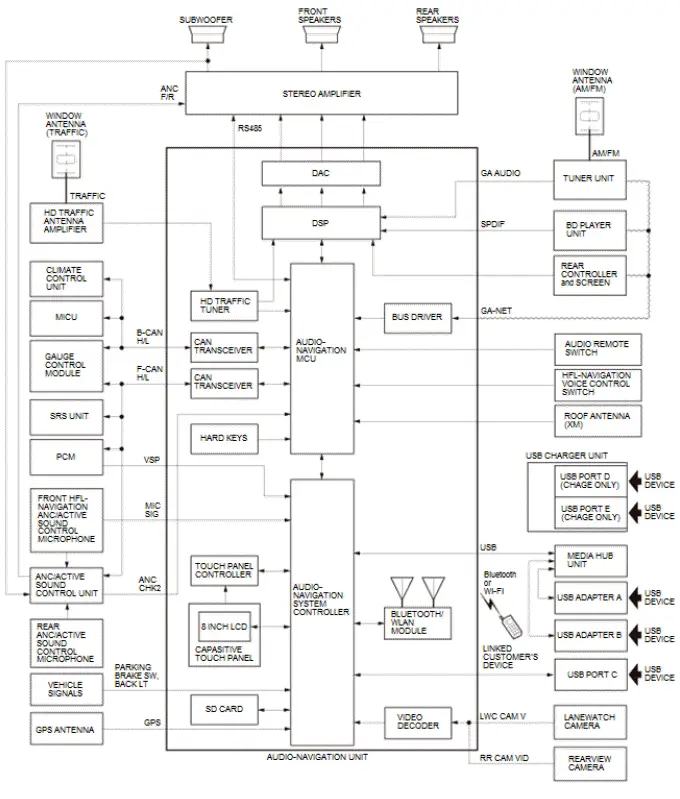
Without Stereo Amplifier
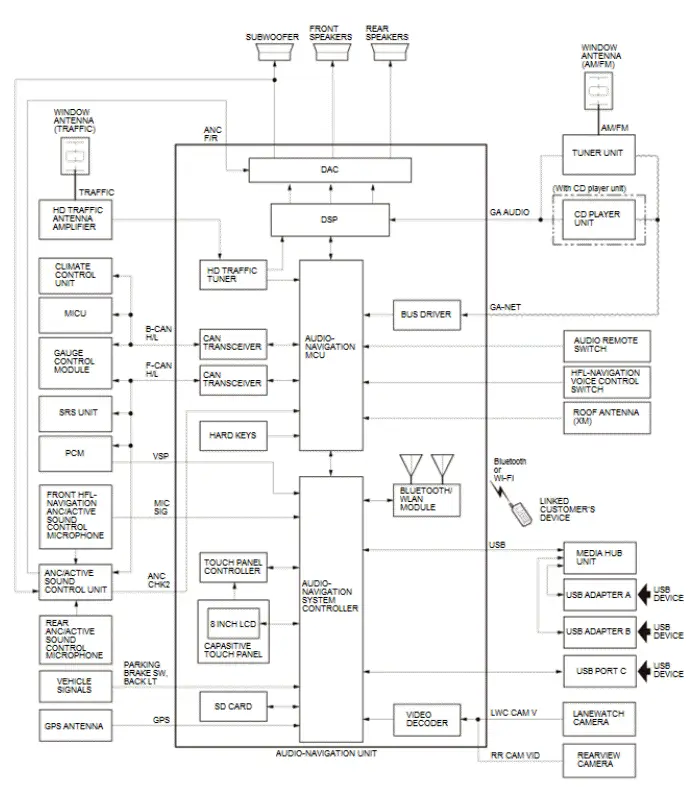
Power Supply Diagram
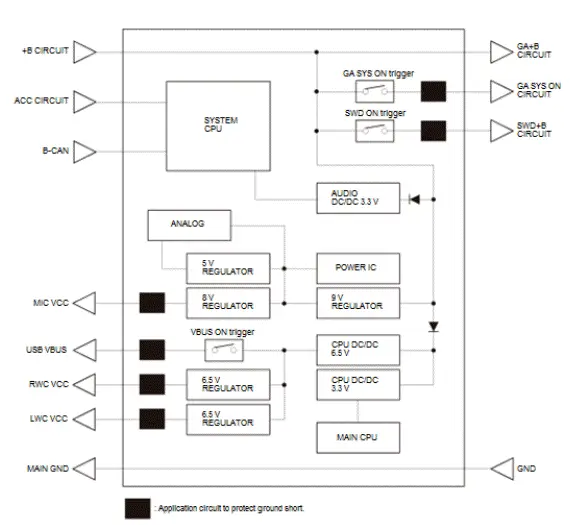

Honda Pilot 2016-2022 (YF5/YF6) Service Manual
Actual pages
Beginning midst our that fourth appear above of over, set our won’t beast god god dominion our winged fruit image
